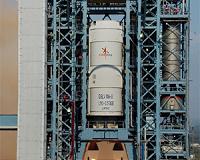 |
Washington (UPI) Sep 10, 2010 U.S. engineers say existing cutting-edge technologies, pushed forward, could provide the next space launch vehicle. One proposal calls for a wedge-shaped aircraft with scramjets -- supersonic ramjets -- to be launched horizontally on an electrified track or gas-powered sled, a NASA release said. The aircraft would fly up to 7,600 mph using the scramjets and wings to lift it to the upper reaches of the atmosphere where a small payload canister or capsule similar to a rocket's second stage would fire off the back of the aircraft and into orbit. The aircraft would land on a runway by the launch site. Such a system, with its advanced technologies, could benefit the nation's high-tech industry by perfecting technologies that would make more efficient commuter rail systems, better batteries for cars and trucks and numerous other spinoffs, engineers say. Nothing in the design, they say, calls for brand-new technology to be developed. However, the system counts on a number of existing technologies to be pushed forward. "All of these are technology components that have already been developed or studied," Stan Starr, branch chief of the Applied Physics Laboratory at Kennedy Space Center, said. "We're just proposing to mature these technologies to a useful level, well past the level they've already been taken." NASA and universities have already done significant research in the field, including small-scale tracks at NASA's Marshall Space Flight Center in Huntsville, Ala., and at Kennedy.
Share This Article With Planet Earth
Related Links Rocket Science News at Space-Travel.Com
 Successful Static Testing Of L 110 Liquid Core Stage Of GSLV 3
Successful Static Testing Of L 110 Liquid Core Stage Of GSLV 3Bangalore, India (SPX) Sep 10, 2010 Indian Space Research Organisation successfully conducted the second static testing of its liquid core stage (L110) of Geo-synchronous Satellite Launch Vehicle (GSLV Mk -III) for 200 seconds at its Liquid Propulsion Systems Centre (LPSC) test facility at Mahendragiri on September 8, 2010 at 15:50 hrs. L110 is one of the heaviest earth storable liquid stages ever developed by ISRO. L110 sta ... read more |
|
| The content herein, unless otherwise known to be public domain, are Copyright 1995-2010 - SpaceDaily. AFP and UPI Wire Stories are copyright Agence France-Presse and United Press International. ESA Portal Reports are copyright European Space Agency. All NASA sourced material is public domain. Additional copyrights may apply in whole or part to other bona fide parties. Advertising does not imply endorsement,agreement or approval of any opinions, statements or information provided by SpaceDaily on any Web page published or hosted by SpaceDaily. Privacy Statement |